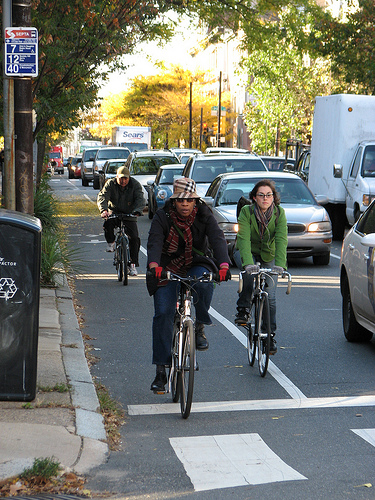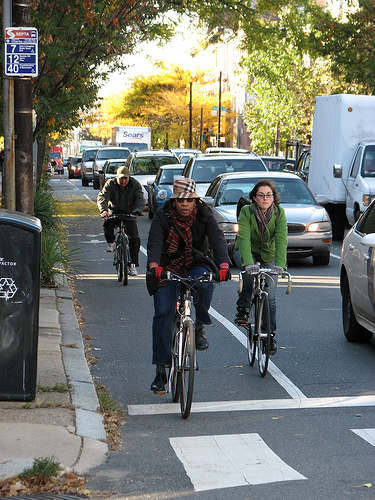 During last year’s transit strike in Philadelphia, bike ridership boomed. That likely made streets safer for cyclists.Photo: Kyle GradingerIn U.S. cities, there are a lot more people out bicycling than just a few years ago. You might reasonably think that the bicycle crash rate would skyrocket as more people, from wobbly new riders to the outright safety-averse, take to the streets on two wheels.
During last year’s transit strike in Philadelphia, bike ridership boomed. That likely made streets safer for cyclists.Photo: Kyle GradingerIn U.S. cities, there are a lot more people out bicycling than just a few years ago. You might reasonably think that the bicycle crash rate would skyrocket as more people, from wobbly new riders to the outright safety-averse, take to the streets on two wheels.
It’s a fine, common-sense assumption — that happens to be wrong.
Research has been steadily showing, actually, that the more people are out there riding bicycles, the safer bicycling becomes. As ridership goes up, crash rates stay flat. It’s happening in Portland (see page 11 of this report [PDF]). It’s happening in New York City.
Much of the ridership increase is due to cities’ investments in bicycle-specific infrastructure. But the efficacy of that infrastructure for safety is often questioned. And there’s one theory — based on a growing body of data — that suggests that a few painted lines on the road, bike racks, and traffic lights form only part of the safety equation. And maybe a smaller part than we tend to assume.
The phenomenon, dubbed “safety in numbers,” was first identified in 2003, in an academic paper by public health researcher Peter Jacobsen [PDF]. After being asked by officials in Pasadena, Calif., if their city “was a dangerous place to bicycle,” Jacobsen began looking at crash data from various communities where bicycle ridership had fluctuated over time.
What he found surprised him: The number of crashes involving bikes correlated with the number of riders in a community. As ridership fluctuated, so did the crash rate. More riders, fewer crashes; fewer riders, more crashes.
This happened too abruptly, Jacobsen decided, to be caused by slow-moving factors like infrastructure development and cultural change. Bicycling becomes safer when the number of riders increases, he concluded, at least in part because the number of riders increases.
The inverse happens, as well. One data set Jacobsen looked at covered 49 years of biking history in the United Kingdom. Those numbers showed that cycling became safer during the oil crisis of the 1970s, caused by the OPEC oil embargo. Once the crisis ended, both ridership and safety dropped.
This all must sound terribly wonky. Actually, it’s been revolutionary.
The idea of Safety in Numbers has slowly built up steam in traffic safety circles since Jacobsen introduced it. Supporting data continues to quietly (and sometimes dramatically) roll in from around the world, influencing mainly traffic engineers and planners who are trying to figure out how to improve bicycle safety.
Bicycle safety is often seen in a sort of vacuum. Helmets tend to dominate the conversation, with visibility — lights and bright clothing — taking a close second. More sophisticated conversations get deep into infrastructure: Which is better, sharrows, bike lanes, or separated cycle tracks? We discuss educating cyclists in defensive riding techniques and the rules of the road.
These are all good and important efforts. The problem is what’s missing. Here’s the core of Jacobsen’s analysis, from the 2003 “Safety in Numbers” report:
Whose behavior changes, the motorist’s or that of the people walking and bicycling? It seems unlikely that people walking or bicycling obey traffic laws more or defer to motorists more in societies or time periods with greater walking and bicycling. Indeed it seems less likely. … Adaptation in motorist behavior seems more plausible.
So why might this be the case?
When there is a serious bicycle crash, it almost always involves someone driving a car. There are any number of ways drivers become involved in these crashes, primarily involving speed, turning, and the myriad distractions that are common behind the wheel.
But when there are a lot of bicyclists on the road, according to this theory, drivers take notice. They become more attentive, slow down, pass more cautiously, double-check their blind spots, expect the unexpected. They sense that the road has become a more complicated place, and adjust their behavior accordingly. As a result, the road becomes safer, presumably for everyone.
Safety in numbers is an important idea that has shifted the way planners and engineers think about bicycle safety. But it won’t be the final word. We will doubtless see this idea bandied back and forth for some time, especially as academic interest in bicycling and walking increases. As data improves we’ll likely see a more complex relationship emerge among ridership, safety, infrastructure, laws, and culture.
Whatever the variables, as Jacobsen told me in a requisitely wonky email, “The bigger SIN story is that those cities /countries that have encouraged bicycling have been rewarded with more trips by bike, and not just a non-linear increase in injuries, but a decrease in injuries.”
That’s huge. Safety in numbers will prove over time, I suspect, to be the first major theory based on objective data that can break down the double standard we all pedal under. Jacobsen’s research calls into question the foundation of a system in which the convenience of driving is exalted above the basic safety and mobility of people walking and bicycling.


